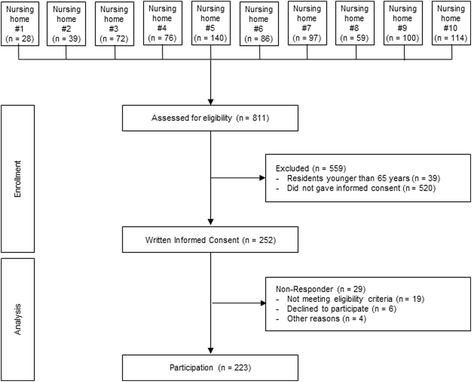Associations between skin barrier characteristics, skin conditions and health of aged nursing home residents: a multi-center prevalence and correlational study
- PMID: 29132305
- PMCID: PMC5683462
- DOI: 10.1186/s12877-017-0655-5
Associations between skin barrier characteristics, skin conditions and health of aged nursing home residents: a multi-center prevalence and correlational study
Abstract
Background: Geriatric patients are affected by a range of skin conditions and dermatological diseases, functional limitations and chronic diseases. Skin problems are highly prevalent in elderly populations. Aim of this study was to investigate possible associations between health, functional and cutaneous variables in aged long-term care residents.
Methods: This observational, cross-sectional, descriptive prevalence study was conducted in a random sample of 10 institutional long-term care facilities in Berlin. In total, n = 223 residents were included. Demographic and functional characteristics, xerosis cutis, incontinence associated dermatitis, pressure ulcers and skin tears were assessed. Stratum corneum hydration, transepidermal water loss, skin surface pH and skin temperature were measured. Data analysis was descriptive and explorative. To explore possible bivariate associations, a correlation matrix was created. The correlation matrix was also used to detect possible collinearity in the subsequent regression analyses.
Results: Mean age (n = 223) was 83.6 years, 67.7% were female. Most residents were affected by xerosis cutis (99.1%; 95% CI: 97.7% - 100.0%). The prevalence of pressure ulcers was 9.0% (95% CI: 5.0% - 13.0%), of incontinence associated dermatitis 35.4% (95% CI: 29.9% - 42.2%) and of skin tears 6.3% (95% CI: 3.2% - 9.5%). Biophysical skin parameters were not associated with overall care dependency, but with age and skin dryness. In general, skin dryness and measured skin barrier parameters were associated between arms and legs indicating similar overall skin characteristics of the residents.
Conclusion: Prevalence of xerosis cutis, pressure ulcers and skin tears were high, indicating the load of these adverse skin conditions in this population. Only few associations of demographic characteristics, skin barrier impairments and the occurrence of dry skin, pressure ulcers, skin tears and incontinence-associated dermatitis have been detected, that might limit the diagnostic value of skin barrier parameters in this population. Overall, the measured skin barrier parameters seem to have limited diagnostic value for the reported skin conditions except xerosis cutis.
Trial registration: This study is registered at https://clinicaltrials.gov/ct2/show/NCT02216526 . Registration date: 8th November 2014.
Keywords: Biophysical measurements; Dermatology; Elderly; Nursing homes; Skin conditions.
Conflict of interest statement
Ethics approval and consent to participate
The study was approved by the ethics committee of the Charité- Universitätsmedizin Berlin (EA1/190/14). Written informed consent was obtained from the residents themselves or their legal representatives prior any study procedure. This study is registered at
Consent for publication
Not Applicable.
Competing interests
The authors declare that they have no competing interests and are alone responsible for the content and writing of the paper. The funding support of Galderma Pharma SA (Switzerland) had no influence on study planning, protocol preparation, study conduct, analyses and reporting.
Publisher’s Note
Springer Nature remains neutral with regard to jurisdictional claims in published maps and institutional affiliations.
References
-
- Hahnel E, Lichterfeld A, Blume-Peytavi U, Kottner J. The epidemiology of skin conditions in the aged: a systematic review. J Tissue Viability. 2016; doi: 10.1016/j.jtv.2016.04.001. - PubMed
-
- Lichterfeld A, Lahmann N, Blume-Peytavi U, Kottner J. Dry skin in nursing care receivers: a multi-centre cross-sectional prevalence study in hospitals and nursing homes. Int J Nurs Stud. 2016; doi:10.1016/j.ijnurstu.2016.01.003. - PubMed
-
- Lichterfeld A, Hahnel E, Blume-Peytavi U, Kottner J. Preventive skin care during skin aging. In: Farage AM, Miller WK, Maibach IH, editors. Textbook of aging skin. Berlin, Heidelberg: Springer Berlin Heidelberg; 2014. pp. 1–12.
-
- Kottner J, Balzer K, Dassen T, Heinze S. Pressure ulcers: a critical review of definitions and classifications. Ostomy Wound Manage. 2009;55:22–29. - PubMed
Publication types
MeSH terms
Associated data
LinkOut - more resources
Full Text Sources
Other Literature Sources
Medical


